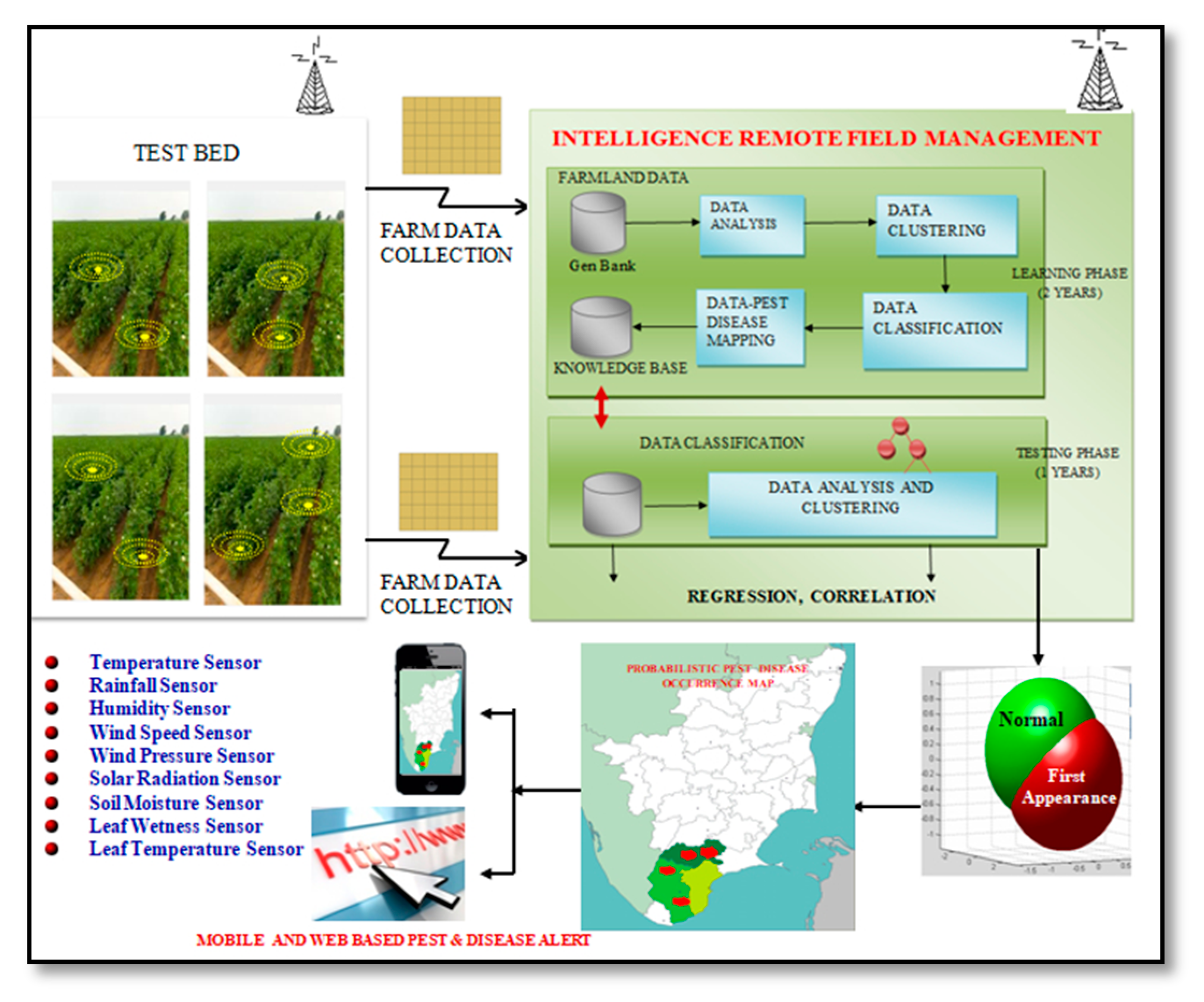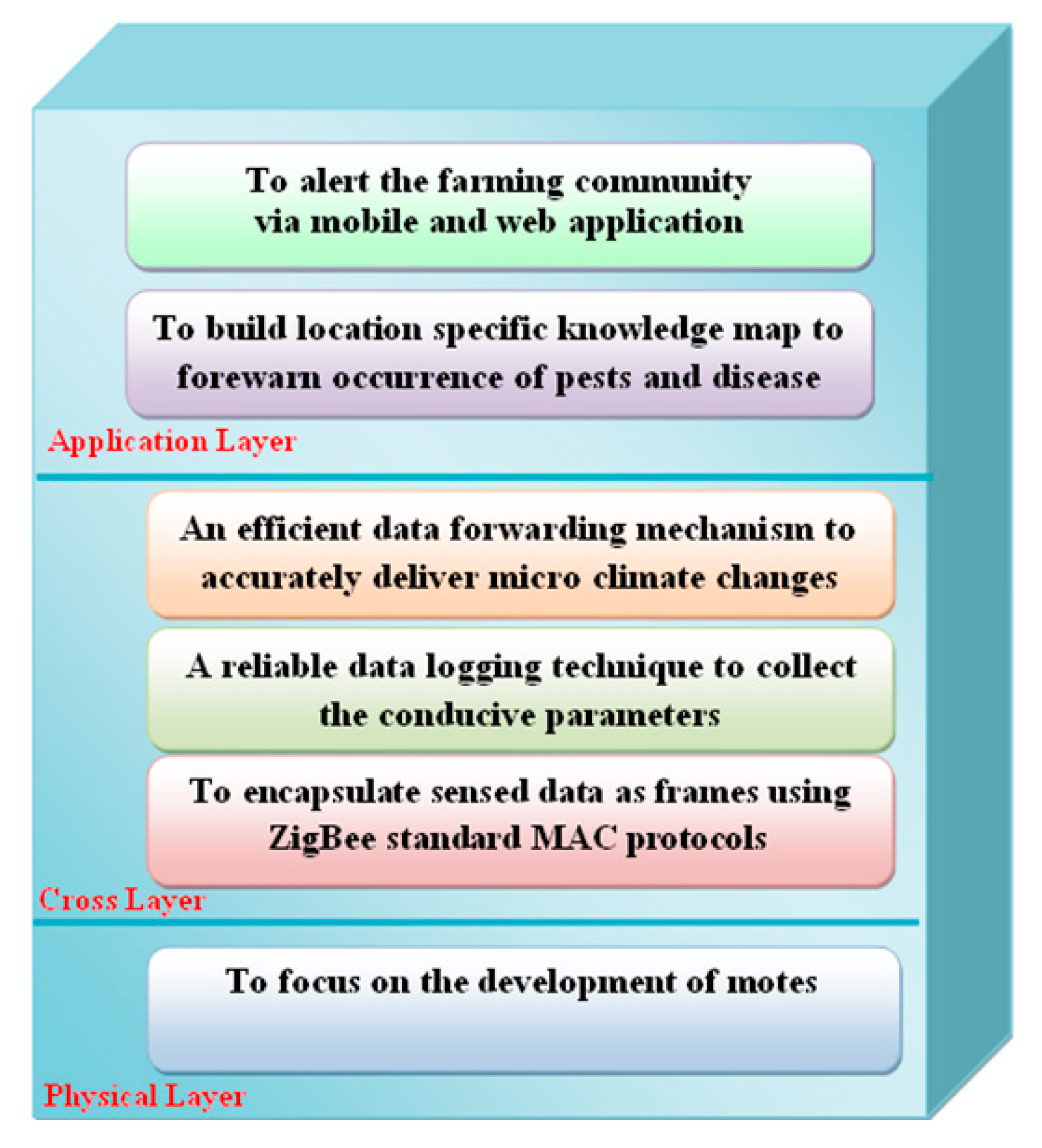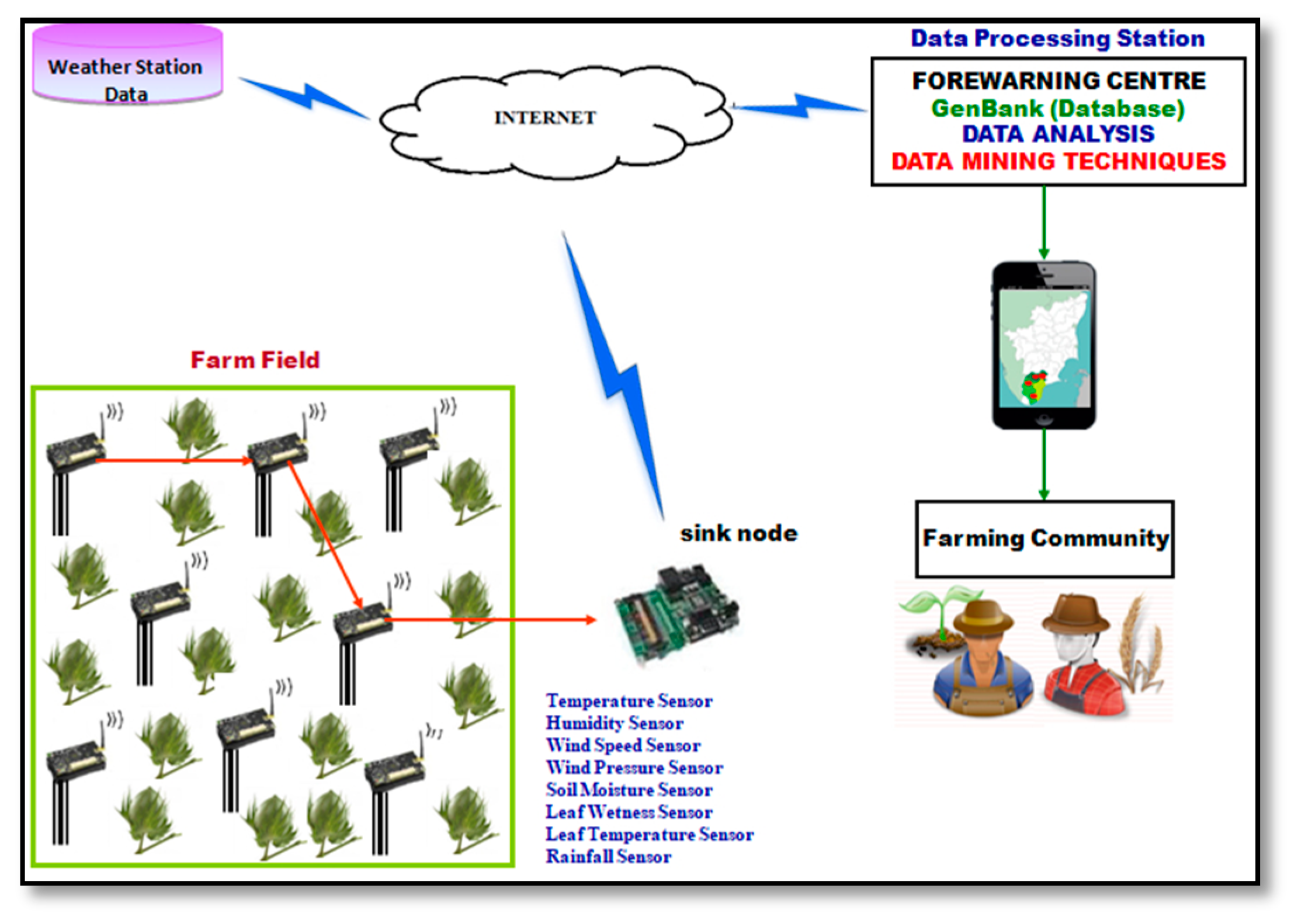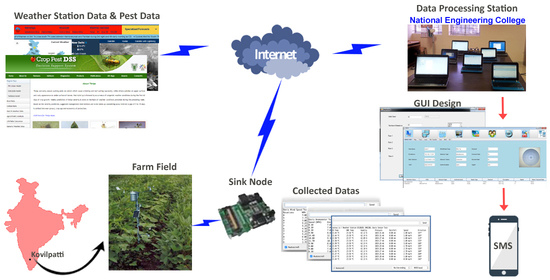Microclimate-Based Pest and Disease Management through a Forewarning System for Sustainable Cotton Production
Abstract
:1. Introduction
- Few pests and diseases forecast models have been developed, and the existing ones have poor predictabilities.
- Sensor technology has not been fully explored in disease prediction.
- Very few intelligent diseases forecast models have been developed based on microclimate influence.
- The available location-specific information on weather-related pest and disease incidence in rain fed crops is scanty, scattered, and inadequate.
- The current forecast information does not reach the farmers in time.
2. Materials and Methods
2.1. Material Used for Cotton Cultivation
2.1.1. Technology Used
2.1.2. Area Used and Duration of the Study
2.1.3. Phenological Study
2.1.4. Data Used
2.2. Methodology Used
3. Results and Discussion
4. Conclusions
Author Contributions
Funding
Acknowledgments
Conflicts of Interest
References
- Balikai, R.A.; Venkatesh, H.; Sagar, D. Development of models to predict insect pest populations-An eco-friendly tactic for pest management. J. Farm Sci. 2019, 32, 1–13. [Google Scholar]
- Illán, J.G.; Bloom, E.H.; Wohleb, C.H.; Wenninger, E.J.; Rondon, S.I.; Jensen, A.S.; Crowder, D.W. Landscape structure and climate drive population dynamics of an insect vector within intensely managed agroecosystems. Ecol. Appl. 2020. [Google Scholar] [CrossRef]
- Cotton Advisory Board (CAB). Available online: https://cotcorp.org.in/statistics.aspx (accessed on 27 October 2020).
- Mahmood, I.; Imadi, S.R.; Shazadi, K.; Gul, A.; Hakeem, K.R.; Akhtar, M.; Abdullah, S. (Eds.) Effects of Pesticides on Environment. In Plant, Soil and Microbes; Springer International Publishing: Cham, Switzerland, 2016. [Google Scholar]
- Patel, R.; Radadia, G.G. Population dynamics of cotton jassid, Amrascabiguttulabiguttula (Ishida) and natural enemies in relation to weather parameters under rainfed conditions. J. Entomol. Zool. Stud. 2018, 6, 664–672. [Google Scholar]
- Saeed, R.; Razaq, M.; Hardy, I.C.W. The importance of alternative host plants as reservoirs of the cotton leaf hopper, Amrascadevastans, and its natural enemies. J. Pest Sci. 2015, 88, 517–531. [Google Scholar] [CrossRef]
- Arzu, Ö.; Dilek, A.; Muhsin, K. Pesticides, Environmental Pollution, and Health. Environmental Health Risk-Hazardous Factors to Living Species; Larramendy, M.L., Soloneski, S., Eds.; IntechOpen: London, UK, 2016. [Google Scholar]
- Marchand, P.A. Synthetic agrochemicals: A necessary clarification about their use exposure and impact in crop protection. Environ. Sci. Pollut. Res. 2019, 26, 17996–18000. [Google Scholar] [CrossRef] [PubMed] [Green Version]
- Saeed, H.; Ehetisham-Ul-Haq, M.; Atiq, M.; Kamran, M.; Idrees, M.; Ali, S.; Burhan, M.; Mohsan, M.; Iqbal, M.; Nazir, S.; et al. Prediction of cotton leaf curl virus disease and its management through resistant germplasm and bio-products. Arch. Phytopathol. Plant Prot. 2018, 51, 170–186. [Google Scholar] [CrossRef]
- Dhawan, A.K. Integrated Pest Management in Cotton. Integrated Pest Management in the Tropics; New India Publishing Agency: New Delhi, India, 2019; pp. 499–575. [Google Scholar]
- Mohammad, Z.A.M.; Manjurul, H.M.; Sirajul, I.; Emran, H.; Sabiha, B.H.; Shahela, B.H.M.; Sakhawat, H. Comparative Study of Integrated Pest Management and Farmers Practices on Sustainable Environment in the Rice Ecosystem. Int. J. Zool. 2016, 2016, 1–12. [Google Scholar] [CrossRef] [Green Version]
- Xiao, Q.; Li, W.; Kai, Y.; Chen, P.; Zhang, J.; Wang, B. Occurrence prediction of pests and diseases in cotton on the basis of weather factors by long short-term memory network. BMC Bioinform. 2019, 20, 688. [Google Scholar] [CrossRef] [PubMed]
- Corrales, D.C.; Corrales, J.C.; Figueroa-Casas, A. Towards Detecting Crop Diseases and Pest by Supervised Learning. Ing. Univ. 2015, 19, 207–228. [Google Scholar] [CrossRef] [Green Version]
- Alves, A.N.; Witenberg, S.R.; Souza, D.L.B. Cotton pests classification in field-based images using deep residual networks. Comput. Electron. Agric. 2020, 174, 105488. [Google Scholar] [CrossRef]
- Collier, R.H. Pest and Disease Prediction Models. Encycl. Appl. Plant Sci. 2017, 31, 120–123. [Google Scholar]
- Gao, D.; Sun, Q.; Hu, B.; Zhang, S.A. Framework for Agricultural Pest and Disease Monitoring Based on Internet-of-Things and Unmanned Aerial Vehicles. Sensors 2020, 20, 1487. [Google Scholar] [CrossRef] [PubMed] [Green Version]
- Practice for Cotton Cultivation from TNAU AgriTech Web Portal. Available online: https://agritech.tnau.ac.in/agriculture/agri_cropproduction_fibre_irrigatedcotton.html (accessed on 2 December 2020).
- Yan, X.; Cao, J.; Sun, L.; Zhou, J.; Wang, S.; Song, A. Accurate analytical-based multi-hop localization with low energy consumption for irregular networks. IEEE Trans. Veh. Technol. 2019, 69, 2021–2033. [Google Scholar] [CrossRef]
- Nagrare, V.S.; Nandini, G.N.; Waghmare, V.N. Cotton Crop Protection Strategies. 2018. Available online: https://www.cicr.org.in/pdf/Cotton_Crop_Protection_Strategies_2018.pdf (accessed on 8 December 2020).
- Sladojevic, S.; Arsenovic, M.; Anderla, A.; Culibrk, D.; Stefanovic, D. Deep Neural Networks Based Recognition of Plant Diseases by Leaf Image Classification. Comput. Intell. Neurosci. 2016, 6, 1–11. [Google Scholar] [CrossRef] [Green Version]
- Boulent, J.; Foucher, S.; Théau, J.; St-Charles, P.L. Convolutional neural networks for the automatic identification of plant diseases. Front. Plant Sci. 2019, 10, 941. [Google Scholar] [CrossRef] [Green Version]
- Jyothi, P.; Mytri, V.A. Prediction Model for Population Dynamics of Cotton Pest (Thrips tabaci Linde) using Multilayer-Perceptron Neural Network. Int. J. Comput. Appl. 2013, 67, 19–26. [Google Scholar] [CrossRef]
- Türkoğlu, M.; Hanbay, D. Plant disease and pest detection using deep learning-based features. Turkish J. Electr. Eng. Comp. Sci. 2019, 27, 1636–1651. [Google Scholar]
- Season and Crop Report 2011–2012 from Tamilnadu Agri Tech Web Portal. Available online: https://agritech.tnau.ac.in/index.html (accessed on 8 December 2020).
- Adhao, A.S.; Pawar, V.R. Automatic Cotton Leaf Disease Diagnosis and Controlling Using Raspberry Pi and IoT. In Intelligent Communication and Computational Technologies; Springer: Singapore, 2018; Part II, Chapter 15; pp. 157–167. [Google Scholar]










| Serial. No. | Nature of the Data | DS1 | DS2 | DS3 | DS4 | DS5 | DS6 | DS7 | DS8 |
|---|---|---|---|---|---|---|---|---|---|
| 1 | Pests and Disease | 1212 | 1325 | 427 | 176 | 917 | 60 | 78 | 677 |
| 2 | No Pests and Disease | 761 | 842 | 635 | 574 | 682 | 120 | 183 | 476 |
| 3 | Total size | 1973 | 2167 | 1062 | 750 | 1599 | 180 | 261 | 1153 |
| Sl. No. | Pest and Disease Name | Conducive Weather Conditions for the Pest and Disease Occurrence |
|---|---|---|
| 1 | Thrips tabaci | Cloudy weather, high temperature |
| 2 | Aphis gossypii | Cloudy weather, high temperature |
| 3 | Amrasca devastans | Cloudy weather, high temperature, moderate rain fall |
| 4 | Pempherulus affinis | Hot weather, high humidity |
| 5 | Ramularia areola | High humidity with low temperature |
| Sl. No. | Districts | Average Area Under Cotton 1 (ha) | Gain Due to Saving in Pesticide Usage 2 (INR) | Gain Due to Additional Yield 3 (INR) | Expected Total Gain for the District as a Whole (INR/Season) |
|---|---|---|---|---|---|
| 1 | Tirunelveli | 1310 | 2,580,700 | 6,340,400 | 8,921,100 |
| 2 | Thoothukudi | 4143 | 8,161,710 | 11,529,969 | 19,691,679 |
| 3 | Virudhunagar | 8603 | 16,947,910 | 29,146,964 | 46,094,874 |
| 4 | Total | 14,056 | 27,690,320 | 47,017,333 | 74,707,653 |
Publisher’s Note: MDPI stays neutral with regard to jurisdictional claims in published maps and institutional affiliations. |
© 2020 by the authors. Licensee MDPI, Basel, Switzerland. This article is an open access article distributed under the terms and conditions of the Creative Commons Attribution (CC BY) license (http://creativecommons.org/licenses/by/4.0/).
Share and Cite
Madasamy, B.; Balasubramaniam, P.; Dutta, R. Microclimate-Based Pest and Disease Management through a Forewarning System for Sustainable Cotton Production. Agriculture 2020, 10, 641. https://doi.org/10.3390/agriculture10120641
Madasamy B, Balasubramaniam P, Dutta R. Microclimate-Based Pest and Disease Management through a Forewarning System for Sustainable Cotton Production. Agriculture. 2020; 10(12):641. https://doi.org/10.3390/agriculture10120641
Chicago/Turabian StyleMadasamy, Bhuvaneswari, Paramasivan Balasubramaniam, and Ritaban Dutta. 2020. "Microclimate-Based Pest and Disease Management through a Forewarning System for Sustainable Cotton Production" Agriculture 10, no. 12: 641. https://doi.org/10.3390/agriculture10120641
APA StyleMadasamy, B., Balasubramaniam, P., & Dutta, R. (2020). Microclimate-Based Pest and Disease Management through a Forewarning System for Sustainable Cotton Production. Agriculture, 10(12), 641. https://doi.org/10.3390/agriculture10120641






